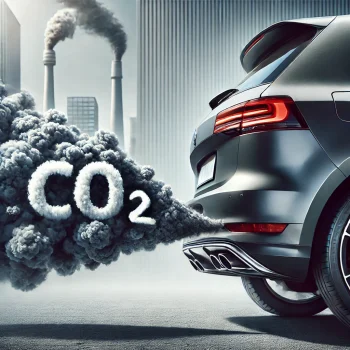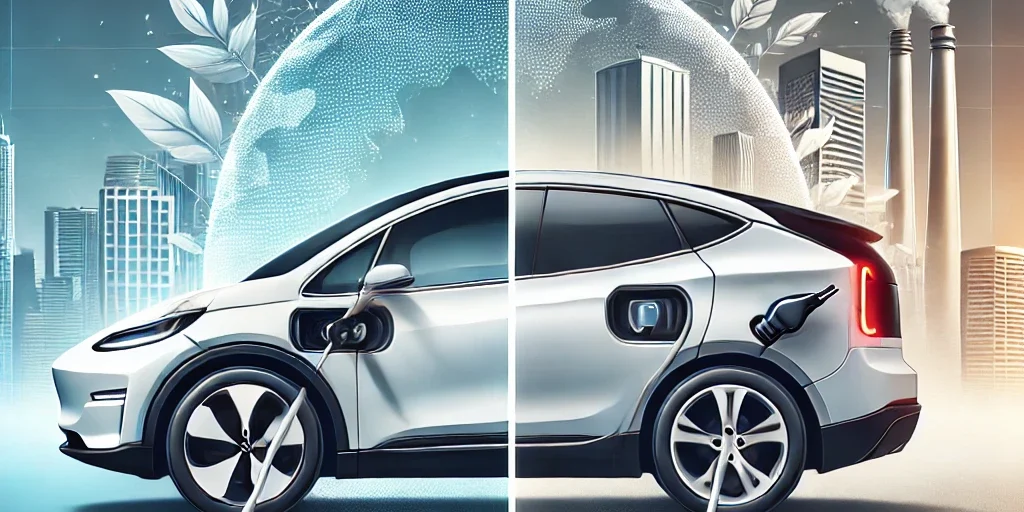Carbon Footprint of Electric vs. Gasoline Cars: A Comparative Analysis
As the world grapples with the impact of climate change, reducing our carbon footprint has never been more crucial. Vehicles are significant contributors to global greenhouse gas emissions, and a shift towards more sustainable options is essential. This article aims to compare the carbon footprints of electric vehicles (EVs) and gasoline cars, offering insights into how they stack up against each other in the race to reduce emissions. We’ll also explore the role of battery manufacturing, international efforts, and how tools like VECTO (Vehicle Energy Consumption Calculation Tool) are shaping the conversation around vehicle emissions.

What is a Carbon Footprint?
A vehicle’s carbon footprint measures the total greenhouse gases emitted throughout its lifecycle—from production to operation and eventual disposal. This measure aids in evaluating the environmental effects of various vehicle types.
Why Do We Need to Reduce the Carbon Footprint?
A carbon footprint is the all greenhouse gases (mainly carbon dioxide) emitted directly or indirectly by human activities. For vehicles, this includes emissions from the manufacturing process, fuel consumption, and even the energy required to charge electric cars. With rising global temperatures, reducing carbon footprints is vital to limiting the severity of climate change. Transportation accounts for approximately 14% of global greenhouse gas emissions, making it a crucial sector to address in tackling the issue.
Reducing our reliance on fossil fuels and shifting to cleaner energy sources can help slow global warming, enhance air quality, and promote a more sustainable future.
Gasoline Cars: Emissions and Impact
1. Operational Emissions
Gasoline cars are driven by internal combustion engines, which burn fossil fuels and release carbon dioxide (CO2) directly into the atmosphere. The level of CO2 emissions is determined by the vehicle’s fuel efficiency. On an average, a gasoline-powered car produces approx 4.6 metric tons of CO2 annually.
2. Manufacturing Impact
The carbon footprint of producing gasoline cars is significant, although usually lower than that of electric vehicles due to their simpler technology. The materials and energy required for engine production, assembly, and shipping generate around 6 to 7 metric tons of CO2 per car.
3. End-of-Life Considerations
Gasoline cars are frequently recycled at the end of their lifespan, but this process also involves emissions, mainly from the disposal of parts that are not easily recycled, such as engine components.
Electric Cars: Emissions and Impact
1. Operational Emissions
Electric cars have zero exhaust running emissions, meaning no direct CO2 is released while driving. However, The emissions generated from the electricity used to charge these vehicles vary based on the energy source. In countries where electricity comes from coal or gas, EVs may still contribute to significant emissions. However, in regions with a cleaner energy mix, EVs can dramatically lower overall carbon footprints.
2. Battery Manufacturing and Carbon Footprint
A major contributor to the carbon footprint of an electric vehicle is its battery. Lithium-ion batteries, which are used in most EVs, require raw materials like lithium, cobalt, and nickel, which must be mined and processed. Battery production can generate between 8 and 12 metric tons of CO2 per vehicle. However, as battery technology improves and recycling becomes more efficient, the carbon amount of EV production is expected to drop.
3. End-of-Life Considerations
Recycling EV batteries is still in its early stages, but it’s crucial for reducing the environmental effect of electric vehicles. Current technologies allow the recycling of certain battery materials, and continued innovation is expected to make this process even greener.
VECTO Tool for Emissions Calculation
VECTO, the Vehicle Energy Consumption Calculation Tool, is a sophisticated tool created by the European Union to precisely measure the carbon footprint of vehicles. It calculates fuel consumption and CO2 emissions for various types of vehicles, particularly focusing on heavy-duty vehicles like trucks and buses. By simulating real-world driving conditions, VECTO provides a clear picture of how vehicles perform and contributes to transparent and consistent reporting on emissions.
VECTO is now a vital tool in Europe’s strategy to regulate vehicle emissions and set future targets for reduction.
Government Policies: India vs. Europe
India:
India has launched several initiatives to promote electric mobility and reduce carbon emissions. The Faster Adoption and Manufacturing of Hybrid and Electric Vehicles (FAME) scheme provides financial incentives to encourage the adoption of EVs. India aims to cut the carbon intensity of its economy by 45% by 2030, relative to 2005 levels. The country also aims to achieve net-zero carbon emissions by 2070.
Europe:
In contrast, European countries have much more aggressive policies. The European Green Deal is an extensive plan designed to make Europe the first continent to achieve carbon neutrality by 2050. Countries like Norway have pledged to phase out new gasoline and diesel cars by 2025. The EU also imposes strict CO2 emissions limits on automakers, forcing them to innovate towards cleaner technologies.
International Comparison of Carbon Footprint Reduction in Cars
Across the world, countries are focusing on reducing vehicle emissions through various policies and incentives. Here’s a look at some countries leading the charge, ranked by their success in reducing their carbon footprints:
Norway
Norway is leading the way, with over 54% of new cars sold in 2020 being fully electric. The country has set a goal for all new car sales to be zero-emission by 2025.Netherlands
The Netherlands is advancing the adoption of electric vehicles, with nearly 25% of all new cars sold being electric in 2021. The country also plans to prohibit the sale of petrol and diesel vehicles by 2030.Germany
As Europe’s largest car market, Germany has set a goal to reduce its carbon footprint by 55% by 2030. The country is investing heavily in EV infrastructure and aims to put 10 million electric vehicles on the road by 2030.China
China, the world’s largest auto market, aims to have 40% of new cars sold be electric by 2030. The government is also working on reducing emissions from manufacturing processes.United States
While the U.S. has seen slower adoption of electric vehicles compared to European nations, policies like California’s ban on new gasoline car sales by 2035 are setting a path for substantial emission reductions.
Countries’ Carbon Footprint Reduction Targets
- India: Net-zero by 2070, with an intermediate target of reducing the carbon intensity by 45% by 2030.
- United Kingdom: Achieving net-zero by 2050, with a goal to reduce emissions minimum 68% by 2030.
- European Union: Targeting a reduction in gas emissions of minimum 55% by 2030 compared to 1990 levels, with the goal of reaching net-zero by 2050.
- China: Targeting peak CO2 emissions by 2030 and achieving carbon neutrality by 2060.
- United States: Pledged to reduce emissions by 50-52% by 2030, aiming for net-zero by 2050.

The Importance of Comparing Carbon Footprints in Cars
When comparing the carbon footprints of gasoline and electric cars, it’s essential to look at both the operational and manufacturing phases. While gasoline cars produce more emissions during operation, electric cars have higher upfront emissions due to battery production. However, over the vehicle’s lifetime, especially in locations where renewable energy is prevalent, EVs can significantly reduce total emissions.
Conclusion: Comparative Analysis of EVs and Gasoline Cars
Here’s a quick summary of how electric vehicles and gasoline cars compare across several key parameters:
| Parameter | Gasoline Cars | Electric Cars |
|---|---|---|
| Annual Operational Emissions | ~2.6 – 4.6 metric tons of CO2 | ~0.9 – 1.8 metric tons of CO2 (varies by energy source) |
| Manufacturing Emissions | ~6 – 7 metric tons of CO2 | ~8 – 12 metric tons of CO2 |
| Fuel Economy / Efficiency | 10 – 15 Km/Litre | 6 – 10 Km per kWh |
| Tailpipe Emissions | High (CO2, NOx, particulate matter) | None |
| End-of-Life Emissions | Some emissions from disposal | Emissions related to battery recycling |
| Battery/Engine Lifespan | 150,000 – 200,000 miles | 150,000 – 300,000 miles (battery life) |
| Energy Source Dependency | Not applicable | High (depends on electricity mix) |
| Maintenance Costs | Generally higher (oil changes, exhaust systems, etc.) | Lower (fewer moving parts) |
| Resale Value | Depreciates relatively fast | Higher resale value due to growing demand and incentives |
| Initial Purchase Price | Generally lower | Generally higher, but decreasing with advancements |
As the table illustrates, while electric vehicles have a higher carbon footprint during manufacturing, they offer significant advantages in operational emissions and overall environmental sustainability. In areas with a more sustainable energy mix, EVs far outperform gasoline cars in reducing lifetime carbon footprints. With increasing global targets to reduce emissions, the future of transportation is likely to shift decisively towards electric vehicles.
By making well-informed decisions and embracing cleaner technologies, we can collectively contribute to the reduction of global emissions and create a more sustainable world.
You can read more on similar topic here,
Thank You 🙂


